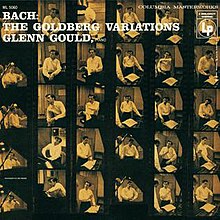Bach: The Goldberg Variations (Glenn Gould recording)
| Goldberg Variations | |
|---|---|

The original Columbia Masterworks album cover shows 30 photos of Gould in the studio, analogous to the 30 Goldberg variations.
|
|
| Studio album by Glenn Gould | |
| Released | January 1956 |
| Recorded | June 10, 1955 – June 16, 1955 |
| Genre | Classical |
| Length | 38:34 |
| Label | Columbia |
Bach: The Goldberg Variations is the 1955 debut album of the Canadian classical pianist Glenn Gould. An interpretation of Johann Sebastian Bach's Goldberg Variations (BWV 988), the work launched Gould's career as a renowned international pianist, and became one of the most well-known piano recordings. Sales were "astonishing" for a classical album: it was reported to have sold 40,000 copies by 1960, and had sold more than 100,000 by the time of Gould's death in 1982. By year 2000, the sale of his 1981 recording of the Goldberg Variations exceeded two million copies.
At the time of the album's release, Bach's Goldberg Variations—a set of 30 contrapuntal variations beginning and ending with an aria—was outside the standard piano repertoire, having been recorded on the instrument only a few times before, either on small labels or unreleased. The work was considered esoteric and technically demanding, requiring awkward hand crossing in various places when played on a piano. Gould's album both established the Goldberg Variations within the contemporary classical repertoire and made him an internationally famous pianist nearly "overnight". First played in concert by Gould in 1954, the composition was a staple of Gould's performances in the years following the recording.
The recordings were made in 1955 at Columbia Records 30th Street studio in Manhattan over four days between June 10 and June 16, a few weeks after Gould signed his contract. Columbia Masterworks Records, the company's classical music division, released the album in January 1956. Bach: The Goldberg Variations became Columbia's bestselling classical album and earned Gould an international reputation. The record is now in the catalog of Sony Classical Records.
At least one record-company executive questioned Gould's choice of the then-obscure Goldberg Variations for his recorded debut. In a 1981 interview, Gould reflected on the studio's situation: "I think the objections [Columbia] had, which were mild and expressed in a most friendly fashion, were quite logical. I was twenty-two years old and proposed doing my recording debut with the Goldberg Variations, which was supposed to be the private preserve, of, perhaps, Wanda Landowska or someone of that generation and stature. They thought that possibly some more modest undertaking was advisable." Then aged 22, Gould was confident and assertive about his work, and prevailed in the decision as to what he would record for his debut—having also ensured that his contract granted him artistic freedom. Columbia recognized his talent and tolerated his eccentricities; on June 25 the company issued a good-natured press release describing Gould's unique habits and accoutrements. He brought to the studio a special piano chair, bottles of pills, and unseasonal winter clothing; once there, he would soak his hands and arms in very hot water for twenty minutes before playing. Gould often had trouble finding a piano he liked; the Variations were recorded on a Steinway piano he had acquired in 1955 (model CD 19), which had been shipped around the northeastern United States for his concerts.
...
Wikipedia
